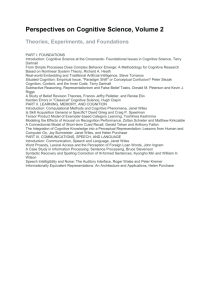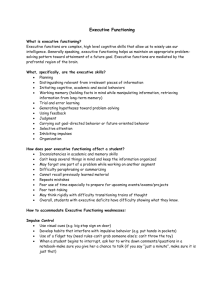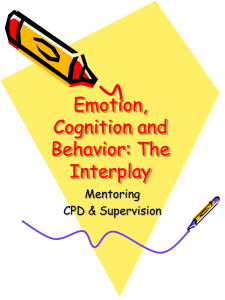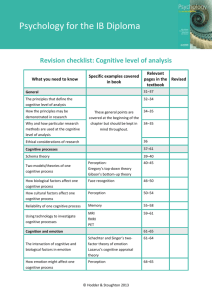Table 1. Training to improve neurocognitive deficits. DRILL AND
advertisement
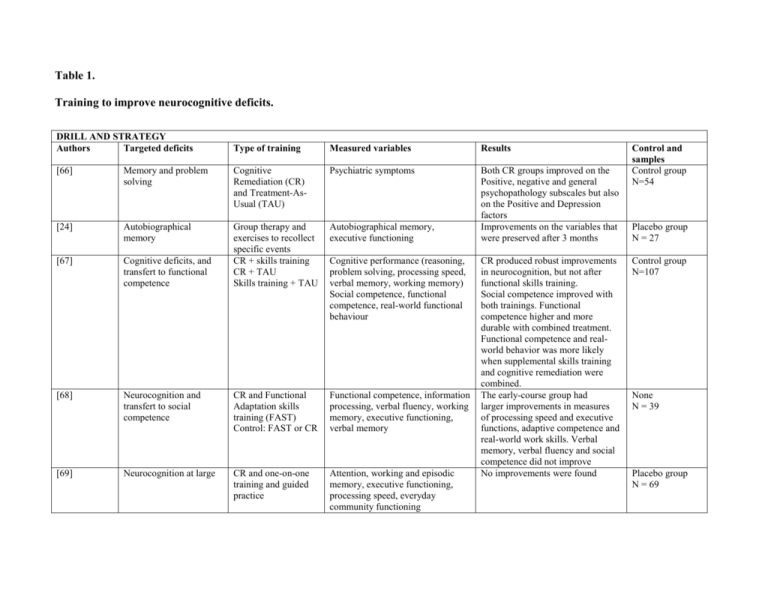
Table 1. Training to improve neurocognitive deficits. DRILL AND STRATEGY Authors Targeted deficits Type of training Measured variables Results Both CR groups improved on the Positive, negative and general psychopathology subscales but also on the Positive and Depression factors Improvements on the variables that were preserved after 3 months [66] Memory and problem solving Cognitive Remediation (CR) and Treatment-AsUsual (TAU) Psychiatric symptoms [24] Autobiographical memory Autobiographical memory, executive functioning [67] Cognitive deficits, and transfert to functional competence Group therapy and exercises to recollect specific events CR + skills training CR + TAU Skills training + TAU [68] Neurocognition and transfert to social competence CR and Functional Adaptation skills training (FAST) Control: FAST or CR Functional competence, information processing, verbal fluency, working memory, executive functioning, verbal memory [69] Neurocognition at large CR and one-on-one training and guided practice Attention, working and episodic memory, executive functioning, processing speed, everyday community functioning Cognitive performance (reasoning, problem solving, processing speed, verbal memory, working memory) Social competence, functional competence, real-world functional behaviour CR produced robust improvements in neurocognition, but not after functional skills training. Social competence improved with both trainings. Functional competence higher and more durable with combined treatment. Functional competence and realworld behavior was more likely when supplemental skills training and cognitive remediation were combined. The early-course group had larger improvements in measures of processing speed and executive functions, adaptive competence and real-world work skills. Verbal memory, verbal fluency and social competence did not improve No improvements were found Control and samples Control group N=54 Placebo group N = 27 Control group N=107 None N = 39 Placebo group N = 69 [70] Psychiatric symptoms and cognition (episodic memory and attention) Neurcognitive Enhancement Therapy (NET) + Work therapy and Verbal memory task based on a dichotic listening (DL) with distracter paradigm NET + Work therapy alone CR and group therapy [71] Attention, memory and executive functioning [72] Executive functioning [26] Verbal and visual memory, sustained attention and executive functioning [73] Verbal memory, working memory, motor speed, verbal fluency, attention, processing speed and executive functioning CR with NEAR [74] Cognitive deficits to improve work outcomes Errorless learning [75] Neurocognition at large Cognitive Adaptation Training (CAT) applied to integrated treatment (IT) consisting of assertive community treatment (ACT) CR with Neuropsychological Educational Approach to Remediation (NEAR) Conventional instruction Cognitive (CR) and supported education Symptoms, attention and memory Significant effect on memory but not on attention or symptoms. nor at 6 months follow up Control group N=125 Verbal learning and memory, executive functioning, visual learning and memory, depression, positive and negative symptoms Social functioning, symptoms and quality of life; executive functioning Significant improvements in neuropsychological functioning, depression and negative symptoms of schizophrenia after CRT Improved social functioning and compliance with IT and ACT. No solid evidence demonstrating that IT improves when adding CAT Control group N = 42 Processing speed, executive functioning , sustained attention, verbal memory, visual memory, reasoning/cognitive flexibility, social/occupational functioning, life skills, quality of life, self-esteem Verbal memory,working memory, motor speed, verbal fluency, attention and speed of information processing, executive functioning Experimental group showed improvement in all variables, gains maintained after 4 months Control group N = 40 Improvement in all outcomes compared to control with CR Control group N = 51 Work performance, job tenure, personal well-being (self-esteem, job satisfaction, work stress) The patients in the errorless learning group performed better on work performance Control group N=40 Self-esteem, short term memory, verbal learning and memory, CR can be successfully integrated into an educational setting. None N=16 Control group N = 62 executive functioning, sustained attention, psychomotor speed, educational attainment Improvements in concentration , learning, some aspects of executive functioning, psychosis symptomatology For TSWP+SE, improvement in executive functioning and in the composite cognition score. Improved significantly more on Depression and Autistic preoccupation (symptoms). Participants were significantly more likely to work, worked more hours and earned more wages In TSWP+SE, over 2-3 years, participants were more likely to work, held more jobs, worked more weeks, worked more hours, and earned more wages. Cognitive functioning and symptoms not assessed. PS improved problem solving skills [76] Cognitive deficits to improve work outcomes Thinking Skills for Work Program (TSWP) + Supported Employment (SE) and Supported Employment only Attention, psychomotor speed, information processing speed, verbal learning and memory, executive functioning, premorbid academic achievement, symptoms, employment outcomes [29] Cognitive deficits to improve work outcomes Thinking Skills for Work Program (TSWP) + Supported Employment (SE) and Supported Employment only Work outcomes [77] Problem-solving Problem-solving, memory, verbal knowledge, independent living [78] Cognitive differentiation, social perception, communication, social skills, and interpersonal problem solving Social functioning and neurocognitive deficits Computer-assisted problem-solving remediation (PS), memory remediation or TAU Integrated Psychological Therapy (IPT) intellectual ability, memory, verbal fluency, executive functioning and psychosocial functioning Improvement in memory and executive functioning for those with cognitive impairments Control group N = 27 CR and Cognitive Behavior Therapy (CBT) for control Working memory, psychomotor speed, verbal memory, nonverbal memory, and executive functioning, and social functioning Control group N = 40 CR Verbal and working memory, speed/coordination, selection attention, semantic and letter fluency, executive functioning , sustained attention, interpersonal Overall improvement in neurcognition especially in verbal and nonverbal memory and executive functioning. Improvement in social functioning 3, 6 and months follow up: improvements in attention, psychomotor coordination, cognitive flexibility [79] [27] Verbal and working memory, selective attention and semantic fluency Control group N = 44 Control group N = 44 Control group N = 54 Placebo condition N = 100 [80] Memory and executive functioning One program including 1) paperand-pencil training 2) computer exercises [81] Attention [82] Neurocognition linked to social competence and behavior [28] Memory, attention, vigilance, executive functioning Attention Process Training (APT) and attention-shaping procedure after Integrated Psychological Therapy (IPT), supportive therapy and TAU CR alone or CR+pharmacotherapy [83] Cognitive deficits and negative symptoms [30] Memory, cognitive flexibility and planning [31] Memory, cognitive flexibility and planning Cognitive strategy training (CAST) and training of selfmanagement skills for negative symptoms (TSSN) Neurocognitive remediation and intensive occupational therapy (control) CR and Intensive occupational therapy [50] Memory, cognitive CR and TAU relations, instrumental role, selfdirectedness Visual attention, cognitive flexibility, sustained attention, inhibition, working memory, longterm verbal memory, executive functioning, planning Verbal learning, sustained attention Social competence, pre-attentional processing, attention, memory, executive functioning and symptoms Attention, learning, memory, executive functioning, functional capacity, negative symptoms, subjective quality of life Attention, verbal memory and planning, social withdrawal/social anhedonia, lack of drive, affect flattening Cognitive flexibility, planning and working memory. Social behaviour, self-esteem Memory, working memory, cognitive flexibility, response inhibition, planning, symptoms and functioning, self-esteem Working Memory, cognitive CR showed improvements in neuroand socio-cognitive functions but not on arousal or cognitive flexibility Placebo group N = 59 Dramatic improvement in attentiveness in APT but attentionshaping procedure appears to account for the change IPT improved social competence only Control group N = 31 CR improved verbal and visual memory at 3 months, not maintained at 6 months. Verbal learning, executive functioning and attention improved at 6 months. Quality of life improvements at 3 months, increased at 6 months CAST=Greater improvement on attention and verbal memory but not planning ability. Higher job placement TSSN=no improvement in negative symptoms Improvements in cognitive flexibility and working memory no changes in symptoms or social functioning, 6 month follow up Control group N = 38 Effects of CR at follow-up are still significant on working memory, there were no more effects on selfesteem, 3 and 6 month follow up Improvement in working memory Control group N = 33 Control group N = 90 Control group N= 138 Control group N = 33 Control Group flexibility and planning [32] Memory, cognitive flexibility and planning DRILL AND PRACTICE [84] Neurocognitive deficits [44] Working memory deficits [56] Cognitive deficits to improve work outcomes [85] Attention, memory and executive functioning [46] Functional outcomes (follow up study using the same NET program so classified here instead of in Table 2) Neurocognition, negative symptoms, self-esteem [86] [87] Repetition and memory flexibility, and planning, Secondary: self-esteem, positive and negative symptoms, social functioning Memory, cognitive flexibility, planning, social behaviour, quality of life, self-esteem and cognitive flexibility, Memory improvement predicted improvement in social functioning. N=85 CR improved cognitive flexibility, social functioning, 14 et 18 weeks follow up Control group N = 40 Neurocognitive enhancement therapy (NET) & working therapy (WT) CR and working therapy (WT) Cognitive flexibility, social inference, emotion recognition, abstract thought, verbal learning, memory Attention, memory and executive functioning NET + WT greater improvements in executive functioning, working memory and affect recognition Control group N=65 Control group N = 102 Neurocognitive enhancement therapy (NET) + work therapy Neurocognitive enhancement therapy (NET) + Work therapy Work productivity (hours and dollars earned) CRT+WT yield greater improvements and effects remain over time (6 months) Patients worked more hours, had more dollars earned and tended to have more competitive-wage employment Significant improvements in working memory and executive functioning. Both groups had a significant effect on memory (verbal and visual) Work hours, employment rates NET+VOC patients worked more hours during the 12 month followup period and they had higher rates of employment Control group N = 72 Attentional deficit, verbal and auditory memory, general level of cognitive functioning, negative symptoms, self-esteem Orientation, attention, calculations, constructions, memory, language, and reasoning CACR improved verbal/conceptual learning and memory and executive functioning Placebo group N = 34 Improvement of overall cognition Control group N = 27 CR with remembering, complex planning, problem-solving and TAU Work therapy alone Neurocognitive Enhancement Therapy (NET) + vocational program (VOC) Computer-assisted cognitive rehabilitation (CACR) Virtual reality training Working memory, verbal and nonverbal memory, thought disorder, executive functioning Control group N = 145 Control group N=145 [88] Attention/concentration, working memory, logic, and executive functions CR [89] Cognitive deficits Pharmacotherapy and cognitive retraining (CR) together 1) drug+CR, 2) drug + control CR, 3) placebo + CR, 4) placebo+control CR [33] Executive functioning (and metacognition) Problem Solving and Cognitive Flexibility training (REPYFLEC) [43] Attentional deficit [38] Verbal and global cognition Computer-Assisted cognitive rehabilitation or computer games Auditory training [39] Cognition in general Targeted cognitive training (TCT) [25] Cognitive deficits in Computerized Attention/vigilance, verbal/nonverbal working memory, verbal and visual learning and memory, speed of processing, reasoning, problemsolving, quality of life and social autonomy Verbal working memory, attention/vigilance Measures of tolerability and safety Improvements in attention/vigilance, verbal memory, problem solving Control group N = 77 CR- significant improvement in verbal working memory. Trend toward improvement in Attention/Vigilance Control groups N = 104 Verbal and visual memory. cognitive flexibility, inhibition of impulsive responses, planning and organization, working memory and time-estimation capacity, attention, processing speed and cognitive flexibility social behavior and relationships, autonomy, employment-occupation and leisure, self-care, social behavior and autonomy Various measures of attention such as trail making, letter-cancellation, Stroop, seach-a-word, etc. Significant improvements in executive function, negative symptoms and Positive change in life skills and psychosocial functioning. Skills maintained at follow-up especially in self-care, social behavior and employmentoccupation. Control group N = 62 Both groups improved in lettercancellation task due to practice effect Control group N = 10 Global cognition, speed of processing, verbal memory/learning, problem-solving, nonverbal memory, visual learning/memory, social cognition Global cognition, speed of processing, verbal working and learning memory and cognitive control Cognitive deficits, more Strong improvement in verbal and global cognition Placebo group N = 55 TCT improvements in verbal learning/memory and cognitive control even 6 months after therapy Control group N=32 Significantly greater improvements Control group memory cognitive remediation training - digits sequenced recall and words sequenced recall (control: work therapy only) Vocational Program (VOC) and NET+VOC [47] Memory, attention, cognitive flexibility [90] Neural correlates of emotion identification Training of Affect Recognition (TAR) and TAU [34] Effects of age on cognitive functioning CR and TAU [8] attention, memory, language and problemsolving CR and computerskills training [91] Cognitive functioning in general CR [35] Cognitive functioning Attention Process Training (APT) [92] Attention and information processing [93] Memory Continuous Performance Test (CPT) Memory remediation (MR), problemsolving remediation and TAU specifically memory on the computerized memory task (digits sequenced recall) remained at the 6 month follow up N = 94 Cognitive flexibility and executive functioning, working memory, visual and verbal memory, social cognition Emotion identification, emotion discrimination, digit symbol, digit span, symptoms, neural activation VOC+NET greater improvement on all outcomes. No improvement in affect recognition after 1 year TAR improved performance in emotion recognition and discrimination more than TAU and controls. Psychopathological status improvements for both TAR and TAU CR improved working memory only in younger group Placebo group N = 72 CR improved working memory but both groups showed improvement on other measures Placebo group N = 42 Cognitive remediation improvements in overall cognitive functioning, psychomotor speed, and verbal learning Control group N=85 Placebo group N = 24 Attention and negative symptoms Neither group improved in symptoms and attention and memory measures. APT group had higher performance on executive function CPT improved both measures Memory, verbal learning, problemsolving MR improved memory but not verbal recall Control group N = 54 Working memory, cognitive flexibility and planning. Groups split on age Working memory, verbal episodic memory, speed of processing, visual episodic memory, reasoning and problem-solving Attention, psychomotor speed, verbal working memory, verbal learning and memory and executive functioning, information processing speed, academic achievement Attention, memory and executive functioning Other: positive and negative symptoms Control group and healthy controls N = 30 Control group N = 134 Control group N = 54 [94] Cognitive impairment Brain Fitness Program (BFP) [36] Divergent thinking [58] Visual motion processing Rock-paper-scissors task, calculation tiles task Target discrimination [37] Cognitive and daily functioning deficits (but concentrating on the neurobiological mechanism that underline them) Dysfunctional organization of the auditory/verbal system [95] [40] Brain oscillary activity, linked to dysfunctional information processing [41] Verbal memory and learning, processing speed, working memory and attention [96] Cognitive deficits CR and Social Skills Training Targeted auditory/verbal discrimination Training (TAD) or CRT (CogPack) Specific cognitive exercises (CE) fostering auditory/verbal discrimination or standard broad-range cognitive training (CP) CR CR (Cogpack) Cognitive performance (CogStat) Functional capacity, auditory processing speed for verbal and non-verbal tasks Idea, design and letter fluency, digit span, social functioning BFP training improved auditory processing speed but no effect on cognitive impairments None N = 55 Improvements in idea fluency, functioning, and interpersonal relations Greater perceptual improvement in schizophrenia Brain networks activation pattern significantly changed in patients exposed to the cognitive treatment in the sense of normalizing toward the patterns observed in healthy control subjects Improvement in verbal learning and memory for TAD but no effect on clinical symptoms Control group N = 17 Verbal memory, global functioning, brain oscillary activity CE improves brain oscillary activity and reduces information processing dysfunction Control group and healthy controls N = 51 Verbal memory, visual working memory, visuo-spatial memory, processing speed, psychomotor speed, working memory, verbal fluency, attention, visual-perceptual function Memory functions, attention, concentration, logical abilities, verbal reasoning Patients in all groups improved in measures of information processing, verbal memory, and visuospatial memory One placebo group and one control group N = 44 Cogpack improves cognitive functioning in persons at risk. Specifically at risk group improve in long-term memory functions, attention, and concentration. Patients with schizophrenia – no Control group N =16 schizophrenia N= 10 at risk Perceptual motion and direction processing Functional and structural connectivity brain changes Verbal learning and fluency, recall, working memory, clinical symptoms as exploratory measure Healthy controls N = 27 Control group N= 30 Control group N = 39 [97] Planning and problemsolving, processing speed, memory and attention Plan-a-day And Training for basic cognition [98] Verbal learning and processing speed Impairment in reality monitoring CR [45] [42] Visual and auditory learning CR Planning ability, problem-solving, global assessment, functional capacity, working memory, verbal memory, processing speed and inhibition Word fluency, memory and recall, Reality monitoring Prefrontal cortex activity improvement. Both groups improved in measures of cognitive functioning and functional capacity. Plan-a-day improved planning All outcomes improved in CR Improvement in reality monitoring that correlated with increased medial prefrontal cortex activity (related to improvement in social functioning 6 months later) None N = 89 Control group N = 42 Control group N= 31 (schizophrenia) N= 15 healthy controls CR consisting of Visual memory, visual-spatial Visual training strongly Placebo control visual, auditory and memory, auditory verbal memory, predicts visual learning but not N = 14 cognitive control verbal and letter learning auditory learning [51] Perceptual, memory and Sustained and Visual word, visual dot localization, After training, most participants Control group motor functions repeated training with motor processing performed as well or better than and healthy no instructions, best controls on tasks controls increasingly N = 22 demanding tasks Note. CR=cognitive remediation. NEAR= Neuropsychological Educational Approach to Remediation. TAU=treatment-as-usual, NET=Neurocognitive Enhancement Therapy. Table 2. Training to improve sociocognitive deficits. DRILL AND STRATEGY Authors Targeted deficits [99] Social context appraisal [100] Social cognition deficits [101] Emotion perception, attributional style, and theory of mind [102] Social cue recognition [103] Emotional intelligence [104] Learning and interpretation of social situations [105] Perception and interpretation of social situations Emotion perception [106] Type of training Measured variables Results Social cognition enhancement training (SCET) and standard psychiatric rehab social cognition and interaction training (SCIT) and Control: coping skills groups SCIT and coping skills groups Perceptual organization and sequencing in social contexts, emotion recognition In SCET, some variables improved after 2 months, others after 6 months Emotion and social perception, theory of mind, attributional style, cognitive flexibility, and social relationships Improved in all sociocogntive measures. Better self-reported social relationships Control group N = 28 Facial emotion identification and discrimination, social perception, theory of mind, attributional style and ambiguity, cognitive flexibility Social cue recognition Improvement in all aspects for participants in SCIT Control group N = 18 Better recognition of social cues in vigilance+memory Control group N = 40 Emotional Intelligence CET group improved in emotional intelligence Control group N=38 Sustained and selective attention, functional outcome, social perception Improvement in all variables in therapy group, maintained at 6 months Control group N = 18 Social perception, attention, psychopathology and social functioning Emotion perception in self and IPT improved social perception. No differences in attention or symptoms between groups EMT improved emotion perception, Control group N = 20 Vigilance+memory training or vigilance alone Cognitive enhancement therapy (CET) and enriched supportive therapy (EST) Stimulus identification, interpretation of images and assignment of title Integrated Psychological Therapy (IPT) Emotion Control and samples Control group N = 34 Control group Management Training (EMT) or problem-solving others, social adjustment, coping strategies, psychopathology Facial emotion identification, social perception, attributional style, theory of mind, speed of processing, attention/vigilance, working memory, verbal and visual learning, reasoning, problemsolving and social cognition Emotional processing, social perception, attributional bias, and mentalizing [57] Social cognitive skills Presentations, group practice and training exercises [107] Social cognitive deficits [108] Theory of Mind (ToM) [109] Emotion perception Socio-cognitive skills training (SCST) Other conditions 1: Cognitive Remediation (CR) 2: standard illness management skills training, 3: Hybrid treatment that combined elements of SCST and neurocognitive remediation Analyses and reasoning about social interaction scenes CR and computerized Emotion Perception intervention compared with CR only [48] Emotion recognition and ToM Emotion and ToM Imitation Training and problem-solving ToM, symptoms, psychopathology, attribution Emotion recognition, emotion discrimination, personal and social performance (also neurocognition) Psychopathology, symptoms, emotion recognition, ToM, neurocognition, flexibility, social functioning, attribution, social adjustment and psychopathology. At 4 month follow up, gains maintained in social adjustment and psychopathology only Improvement in facial affect perception only N = 22 The SCST group demonstrated greater improvements over time than comparison groups in the social cognitive domain of emotional processing, including improvement in measures of facial affect perception and emotion management. Control Group N= 68 Slight improvement in ToM (not significant) in training group from first to second training session. No improvement in symptoms Combined CR with emotion perception remediation produced greater improvements in emotion recognition, emotion discrimination, social functioning, and neurocognition Training improved sociocognition (strongest was emotion recognition) and social functioning Control group N = 14 Control group N = 31 Control group N = 59 Control group N = 32 neurophysiological activation Theory of mind, Social understanding, Inference of complex mental states from the eyes Working memory, IQ [110] Social cognition State reasoning training for social cognitive impairment (SOCog-MSRT) [111] Social cognition SCIT Emotion perception, attributional style and theory of mind [112] Emotion perception, ToM and social skills SCIT and TreatmentAs-Usual (TAU) [113] Visual attention and facial emotion perception CR and repeated exposure Emotion perception, theory of mind, attributional style, social skills in role-play Emotion recognition [114] Emotion recognition and social perception Social Cognitive Training Program and TAU Emotion recognition, psychopathology, social functioning, social perception [115] Emotional communication, (Perception of facial emotional expression) Computerized emotion training program Identification of emotions, differentiation of facial emotions, working memory [116] Social cognition and quality of life Family-socialcognition and social stimulation (F-SCIT) [117] Social and emotion perception CR Memory, visual-spatial scanning, divided attention, inhibition, emotion perception, theory of mind, empathy, reasoning, attributional style, insight, social functioning, quality of life Emotion and general perception, attention, memory, executive functioning, visual processing, cognitive flexibility and interference DRILL AND PRACTICE Improvement in ability to reason causally about false beliefs, to infer complex mental states from the eyes, and to intuitively understand social situations. However individuals with poorer working memory and lower premorbid IQ did not benefit Improved emotion perception, improved theory of mind, and a reduced tendency to attribute hostile intent to others SCIT+TAU improved emotion perception but improvements on theory of mind inconsistent Improvements in pre-post- means for CRT and maintained one month post-training Training improved social perception between group but no improvement in emotion recognition Compared to baseline significantly better at identification of facial emotions. No changes in differentiation of facial emotions and working memory F-SCIT improved social withdrawal, interpersonal communications, prosocial activities, independence/competence, theory of mind, emotion perception Improvement of emotion perception and executive functioning, other areas of neurocognition not affected None N=14 None N = 17 Control group N = 31 Control group N = 40 Control group N = 14 None N = 20 Control group N = 52 Placebo group N = 42 [118] [49] Deficits in facial affect recognition Training of affect recognition (TAR) Controls groups: (TAU or CR) Facial affect recognition, face recognition, and neurocognitive performance Prosodic affect Training of Affect Facial affect recognition, prosodic recognition, theory of Recognition (TAR) affect recognition, theory of mind, mind and CR social competence in role-play Note. SCIT=social cognition and interaction training. TAU=treatment-as-usual. CR=cognition remediation. Patients under TAR (but not CRT or TAU) significantly improved in facial affect recognition. Patients under CRT improved in verbal memory functions. Larger pre- post- improvements on TAR for all variables Control groups N= 77 Control group N = 38 Table 3. Training to improve both neuro- and sociocognitive deficits. DRILL AND STRATEGY Authors Targeted deficits Type of training Measured variables Results The early-course group had larger improvements in measures of processing speed and executive functions, adaptive competence and real-world work skills. Verbal memory, verbal fluency and social competence did not improve CR produced robust improvements in neurocognition, but not after functional skills training. Social competence improved with both type of training. Functional competence higher and more durable with combined treatment. Functional competence and real-world behavior was more likely when supplemental skills training and cognitive remediation were combined. CET improved social cognition, cognitive style, social adjustment and symptomatology during first year and neurocognition benefits were after 2 years Better efficacy in all measures for combined program compared to usual program [68] Social competence (interest, affect, fluency, clarity, focus) and neurocognition Cognitive Remediation (CR) and Functional Adaptation skills training (FAST) Control: FAST or CR Functional competence, information processing, verbal fluency, working memory, executive functioning, verbal memory [67] Cognitive deficits and functional competence deficits CR + skills training CR + Treatment-AsUsual (TAU) Skills training + TAU Cognitive performance (reasoning, problem solving, processing speed, verbal memory, working memory) Social competence, functional competence, real-world functional behaviour [119] Neurocognition, social cognition and symptoms Neurocognitive ability and processing speed, social cognition and cognitive style, social adjustment and symptomatology [120] Sociocognition: social and emotional perception, attention, concentration, verbal memory [121] Organization, comparison Cognitive Enhancement Therapy (CET) or Enriched Supportive Therapy (EST) One program including 1) CR for neurocognition + 2) Social Skills Training for sociocognition and TAU CR on specific areas: Verbal and non-verbal memory, attention, memory, executive functions, verbal fluency, self-care, underactivity, slowness in task execution, social withdrawal, participation in family life, functional outcome memory, thought process and self- Experimental group showed Control and samples None N = 39 Control group N=107 Control group N = 58 Placebo group N = 60 Placebo group [122] [123] and organization, orientation in space, relations, social skills, integrative thinking Sociocognition and neurocognition Neurocognitive and socialcognitive deficits organization, social skills, categorization concept, functional outcome improvements in cognitive abilities and daily functioning, no difference in self-concept N = 58 Cognitive enhancement therapy (CET) or enriched supported therapy (EST) Cognitive enhancement therapy (CET) Processing speed. neurocognition, cognitive style, social cognition, social adjustment and symptoms 12 months: improvement in neurocognition and processing speed 24 months: Same as 12 months and increase in cognitive style, social cognition and social adjustment Significant effect of CET on measures of processing speed, cognitive style, social cognition, and social adjustment. Only the neurocognitive composite is not significant at 36 months follow-up compared to the two years follow-up. Control group N=121 Processing speed, Neurocognition, social cognition, cognitive style, social adjustment Enriched supportive therapy (EST) [124] [125] [126] Control group N=106 Symptoms, social adjustment, social cognition, cognitive style, neurocognition processing speed Neurocognition and sociocognition CR and enriched supportive therapy (EST) Symptoms, social adjustment, social cognition, cognitive style, neurocognition processing speed Improvement in all domains for schizoaffective and schizophrenia patients. Except for schizophrenia, no improvement in processing speed Control group N=58 Computerized neuroplasticity-based auditory training and Social cognition training (SCT) Auditory perception, emotion identification, social perception, theory of mind tasks, all measures of the MATRICS Gains in neurocognition Gains in emotion identification, social perception, and self-referential source memory. None N = 19 Cognition (attention, memory), social perception, cognitive differentiation CR + psychoeducational programme Symptoms, psychosocial functioning, attention, memory, executive functioning Improvement in psychosocial functioning, reduced symptoms (except negative symptoms) and Improvements were observed for 8 of the 10 cognitive measures. Only verbal long term memory and executive functioning (cognitive flexibility) did not improve Control Group N=25 Psychoeducational programme [127] Cognitive differentiation, attention, memory and social perception CR Symptoms, psychosocial functioning, attention, memory, executive functioning Reduced in symptoms and psychosocial functioning, only verbal long term memory and executive functioning did not improve Control Group N=25 [128] Social cognition and problem solving, planning and memory Cognitive-emotional rehabilitation (REC) and Problem Solving Training (PST) Social and occupational functioning, working memory, psychomotor speed, verbal memory, executive functioning, verbal fluency, theory of mind PST improved planning and memory, REC improved theory of mind and emotion recognition None N = 24 Cognitive remediation component of IPT General attention, verbal memory, working memory, executive functions. Global social functioning, positive negative symptoms Improvements verbal and working memory, improvements in negative and total symptom severity. Functional outcome mediated by improvement in cognitive domains Control Group N=32 Cognitive remediation component of IPT (IPT-cog) or computer-assisted cognitive remediation (CACR) Or rehabilitative interventions Processing speed, working memory, memory in general, executive functioning, global social cognition IPT and CACR improvements in all variables especially speed and processing and working memory and increase in functioning Control group N=90 CR and Standard Rehabilitation Training (SRT) Verbal+working memory, psychomotor speed and coordination, selective and sustained attention, semantic and letter fluency, cognitive flexibility, daily functioning, interpersonal relations Recognition of negative and positive emotions CR+SRT improvements on executive function, attention and daily functioning Control group N = 86 Greater pre-to-post intervention increase in postcentral gyrus activity during emotion recognition Results indicate that combined cognition and social cognition Placebo group N = 22 [129] Selective and Sustained attention, memory, conceptualization abilities, cognitive flexibility, social perception, verbal communication, social skills, and interpersonal problem solving [130] Selective and Sustained attention, memory, conceptualization abilities, cognitive flexibility, social perception, verbal communication, social skills, and interpersonal problem solving DRILL AND PRACTICE [131] Attention, executive functioning, memory quality of life, interpersonal relations, social abilities, autonomy [132] Emotion recognition deficits in the neural mechanisms involved in emotion recognition Auditory-based cognitive training (AT) (Brain Fitness), social cognition training or non- Poscentral gyrus activity (neural region known to support facial emotion specific computer recognition ) training impacts neural mechanisms games (CG). that support social cognition skills. Note. CRT=cognitive remediation training, CBT=cognitive behavioral therapy, TAU=treatment-as-usual, MATRICS= Measurement and Treatment Research to Improve Cognition in Schizophrenia.



